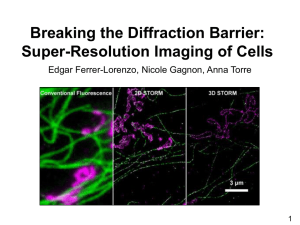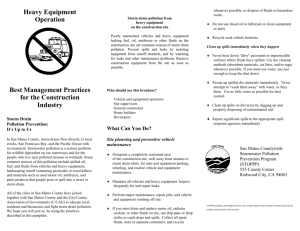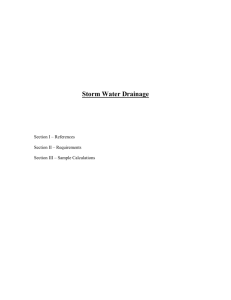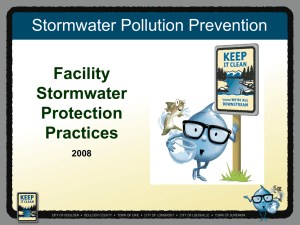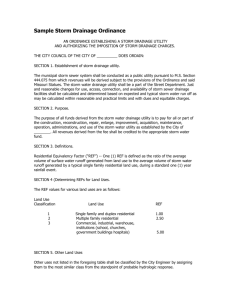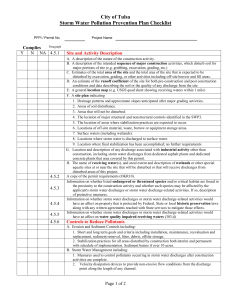Genesee County Design Standards Requirements
advertisement
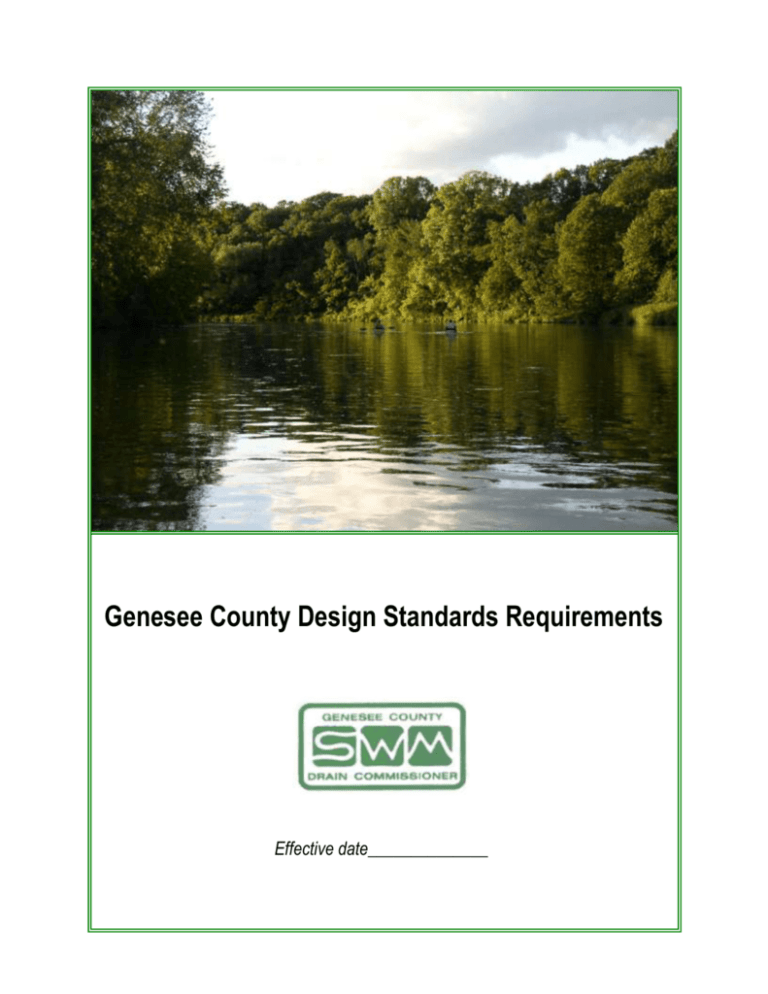
Genesee County Design Standards Requirements Effective date______________ TABLE OF CONTENTS Introduction 1 Role of the Genesee County Drain Commissioner 1 Table 1: Hierarchy of Preferred Best Management Practices (BMPs) 2 Ordinance Applicability 2 Design Manual and Standard Details 2 Storm Water Plan Review Process 3 Submittal Process 4 Figure 1: Submittal Process Flow Chart 4 General Information Requirements 5 Drainage Information Requirements 5 Construction Plan Submittal and Approval 6 Final Approval 7 Genesee County Design Criteria 7 Table 2: Storm Water Requirements 8 Explanation of Requirements 8 Flood Control Requirements 10 Appeal Procedures 10 Permits and Fees for the Genesee County Drain Commissioner 10 Table 3: Permit Fees 11 Table 4: Development Fees 11 Genesee County Design Standards Requirements - Summer 2009 Table of Contents INTRODUCTION The intent of this guide is to provide information specific to Genesee County Drain Commissioner’s design standards to address storm water quantity and quality. This manual will provide the policy framework, implementation procedures and design standards for storm water controls. Note: additional standards and requirements not in this guide are required for developments that design and build their storm systems with the intent to dedicate that system to this office as public. This document outlines design requirements for storm water quantity and storm water quality. Our office has adopted the State’s Low Impact Development (LID) Manual for Michigan to guide the design of proposed Best Management Practices (BMPs) for water quality and that they target the standards provided in this document. This edition of the Rules of the Genesee County Drain Commissioner reflects a storm water management philosophy that considers stream channel protection and storm water quality management in addition to flood control. These revisions are based upon the most current State Permit requirements concerning storm water management. This manual will be updated periodically as additional BMPs are developed and/or as requirements change. The following section outlines basic ideas and principals of storm water management, and provides a conceptual foundation for the design standards contained in this document. THE ROLE OF THE GENESEE COUNTY DRAIN COMMISSIONER The preferred hierarchy discussed above and summarized in Table 1, below, provides a comprehensive framework for evaluating the place and function of individual BMPs within a storm water management system. While the most important BMPs are source controls that preserve and protect the natural environment, the Genesee County Drain Commissioner cannot mandate these. We must look to the staff and officials of local governments, as well as to developers and their design engineers and planners, to implement source reduction approaches. The Office of the Drain Commissioner exercises authority over the design and construction of structural facilities that convey and treat storm water runoff that will be generated from a site as a result of its design. The Drain Commissioner’s Rules will govern the design of such management facilities with the following objectives: Incorporate design standards to control both water quantity and quality. Encourage innovative storm water management practices that meet the criteria contained within these rules. Ensure future maintenance of facilities by planning for it as a part of system design. Make the safety of facilities a priority. Strengthen the protection of natural features. Encourage more effective soil erosion and sedimentation control measures. Genesee County Design Standards Requirements - Summer 2009 Page 1 Table 1: Hierarchy of Preferred Best Management Practices (BMPs) Non-Structural (Source) Controls 1. Preservation of the natural environment 2. Minimization of impervious surfaces 3. Use of vegetated swales and natural storage Structural (Site) Controls 1. Infiltration of runoff on-site (trenches, etc.) 2. Structural (Site) Controls 3. Storm water detention structures 4. Storm water retention ponds * 5. Conveyance off-site 6. Proper maintenance *Storm water retention is allowed when no acceptable outlet is available and soil conditions allow. APPLICABILITY To prevent an increase in non-point source pollution, these Standards requirements shall apply to any earth-disturbing activities greater than or equal to 1-acre (≥1 ac.) on new development or redevelopment projects or earth disturbing activities less than 1-acre on parcels with more than > 0.5 acres of impervious surface which will alter storm water drainage characteristics of the development site. Typically these sites require approval of a plat, a site development plan, building permit, and other permits to be obtained. The aforementioned requirements will include storm water plans that shall be designed, constructed, and maintained to prevent flooding, minimize stream channel impacts, protect water quality, and achieve the purposes of each local community’s storm water ordinance for managing the quantity and quality of storm water runoff. DESIGN MANUAL AND STANDARD DETAILS Local communities may furnish additional policy, criteria and information, for the proper implementation of their own local ordinance. This document together with the State Low Impact Development manual will provide information on water quality and quantity standards as well a list of acceptable storm water treatment practices, including the specific design criteria for each storm water practice. This document and the State LID manual may be updated and expanded from time to time based on federal and state requirements, improvements in engineering, science, monitoring, and local maintenance experience. Storm water treatment practices that are designed and constructed in accordance with these design and sizing criteria will be presumed to meet the minimum water quality performance standards. STORM WATER PLAN REVIEW PROCESS Submittal Requirements: These requirements have been developed in the context of plat submittal under Act 288 of the Public Acts of 1967, as amended, the Michigan Land Division Act. However, they shall also be followed as closely as possible for all other categories of development, including site condominiums and site plans. The following developments will be submitted to the Genesee County Drain Commissioner’s Office for review and approval: Genesee County Design Standards Requirements - Summer 2009 Page 2 1. Plats submittal under Act 288 of the Public Acts of 1967, as amended, the Michigan Land Division Act 2. Applications for permits to discharge to or perform work on a county drain under P.A. 40 of 1956, as amended. Permits are required for any work done to a drain, work within the drain easement or work done that will increase flow to a county drain. 3. Genesee County Road Commission plans that include changes to the storm water system that serves the road. 4. Review of storm water system plans in other classes of developments or redevelopments, when required by local municipalities. 5. Site Condominium plans prepared under Act 59, P.A. 1978, as amended, where local government ordinances require. 6. Mobile home plans prepared under Act 96, PA. 1987. The developer will describe the mechanism to be established for long-term maintenance of the development's private storm water management system, including maintenance schedule and enforcement. County enforcement of private development is limited to permitted activies. Should the proprietor plan to subdivide or develop a given area but wishes to begin with only a portion of the total area, the original preliminary plan will include the proposed general layout for the entire area. The first phase of the subdivision will be clearly superimposed upon the overall plan in order to illustrate clearly the method of development that the proprietor intends to follow. Each subsequent plat or phase will follow the same procedure until the entire area controlled by the proprietor is subdivided. Final acceptance by the Drain Commissioner of only one portion or phase of the subdivision does not ensure final acceptance of any subsequent phases or the overall general plat for the entire area; nor does it mandate that the overall general plat or plan be followed as originally proposed, if deviations or modifications acceptable to the Drain Commissioner are proposed. Preliminary plan approval shall remain in effect for one year. Extensions must be requested in writing. Genesee County Design Standards Requirements - Summer 2009 Page 3 SUBMITTAL PROCESS STEP 1: Pre Development - For each project, developers, their designated design representatives (engineers or architects), the County Road Commission, the County Health Department, municipal officials (zoning, planner, engineer, DPW, building official), and Drain Commissioner's office (Water and Waste Services and Surface Water) will attend a pre-planning conference. The purpose will be to provide design standards, development guidelines, and to identify the type of information developers and their representatives must furnish to comply with the new development procedures. Communication between the project designer and developer, as well as the relevant local officials and developer, are two key components of this framework. *Note: Preliminary Plan is defined to mean the different scheduling scenarios required for each development type (e.g., PUD, plat, mobile home park, site plans and preliminary plats). STEP 2: Preliminary Plan - Review of the conceptual site plan for approval at County level by the appropriate personnel in Water & Waste Services, soil erosion, surface water, and the Road Commission and Health Department. Comments are returned to the owner/client and designer. STEP 3: Coordination Review - A meeting will be set up with the designer, Owner/Client, and review agencies in order to go over the proposed changes to determine if they meet or exceed the Genesee County design standards. It should be noted that review of BMP compliance will occur at the same time as the review of the construction prints. STEP 4: Municipal Review- Guided by Zoning and general ordinances (design standards) local planning commission members will be educated about the new construction standards, and will be given a checklist for reference during site plan review. STEP 5: Final Plan Approval - Construction plans and documents for all Federal, State, and County approvals. Genesee County Design Standards Requirements - Summer 2009 Figure 1: Submittal Process Flow Chart Pre-Development Planning Conference Development of Preliminary Design Conceptual Preliminary Plan* Review *See Note in Step 1 Development of Detailed Design Coordinated Review Meeting Revisions to Design, if necessary Municipal Review Revisions to Design, if necessary Final Construction Approval Page 4 GENERAL INFORMATION REQUIREMENTS All preliminary plans will include the following information: 1. The location of the proposed development by means of a small location map. 2. The township, city, or village in which the parcel is situated. 3. The section and part of section in which the parcel is situated. 4. The number of acres to be developed. 5. Contours, at 2-foot intervals or less, with U.S.G.S. datum. 6. The proposed drainage system for the development. 7. The proposed street, alley and lot layouts and approximate dimensions. 8. The location and description of all on-site and adjacent off-site features that may be relevant in determining the overall requirements for the development. These features may include, but are not limited to, the following: Adjoining roads, subdivisions, and other developments Schools, parks, and cemeteries Drains, sewers, water mains, septic fields and wells High tension power lines, underground transmission lines, gas mains, pipelines, or other utilities Railroads Existing and proposed easements Natural and artificial watercourses, wetlands and wetland boundaries, floodplains, lakes, bays, and lagoons Designated natural areas Soils description in accordance with the USDA NRCS standard soils criteria Any proposed environmental mitigation features 9. Soil borings, as may be required at various locations including the sites of proposed retention/ detention facilities, and as needed in areas where high ground water tables exist. DRAINAGE INFORMATION REQUIREMENTS All preliminary plans will include the following required storm water management information: A. The overall storm water management system for the proposed development, indicating how storm water management will be provided and where the drainage will outlet B. The location of any on-site and/or off-site storm water management facilities and appropriate easements that will be dedicated to the entity responsible for future maintenance C. Information supporting that the outlet is acceptable. An acceptable outlet is a natural watercourse under regulation of Act 451 part 301 Inland Lake and Stream, county drain, county road ditch, or a regulated wetland with an acceptable outlet. The development may discharge across a neighboring private property with the appropriate written approvals/easements. D. A map, at the U.S.G.S. scale, showing the drainage boundary of the proposed development and its relationship with existing drainage patterns E. A description of how drainage, which originates outside of the development limits, and flows onto or across the development, will be managed. Proposed drainage for the development will conform to any established County drainage districts. Proposed drainage should complement any local storm water management plans that may exist and/or comply with any ordinance in effect in the municipality/ies where the proposed development is located. Genesee County Design Standards Requirements - Summer 2009 Page 5 CONSTRUCTION PLAN SUBMITTAL AND APPROVAL The Construction plans will meet all above preliminary requirements plus the following requirements. The Plans will be reviewed to Genesee County Standards to assure that adequate storm drainage will be provided and that the proposed storm water management system provides adequately for water quantity and quality management to ensure protection of property owners, lands, and watercourses both within the proposed development and downstream. One complete set of construction plans are required, and on sheets no larger than 36″ x 48″. The plans shall be drawn to standard engineering scales. The construction plan submittal shall include all required information listed above in the preliminary plan submission and below: A. The property description, the total acreage, and a project location map. If the project is to be completed in phases, the number of acres in each phase shall also be included. B. The proposed project layout with all dimensions, including the proposed drainage system for the project. C. Topographic maps, at two-foot contour intervals or less on U.S.G.S. datum, showing existing and proposed grades, as well as off-site topography over at least 150’ of the adjoining property. Maps will also show all existing watercourses, lakes and wetlands, and the extent of all off-site drainage areas contributing flow to the development. D. Calculations, design data and criteria used for sizing all drainage structures, channels, outlets and retention basins, including weighted runoff coefficient calculations. E. Plans and details of proposed retention/detention facilities. Soil borings may be required at the sites of these facilities. F. Plans, profiles and details of all roads and storm sewers. The storm sewer details will include type, class, and size of pipe; length of run; percent of slope; invert elevations and rim elevations. G. A drainage area map, overlaid onto a copy of the site grading plan, which clearly shows the areas tributary to each inlet and/or storage basin. H. Plans, profiles and details of all open drains, drainage swales and drainage structures. I. Plans and details of the proposed soil erosion and sedimentation control measures, both temporary during construction and permanent. J. All construction specifications for the storm water management facilities. K. Locations of all drain fields as approved by the Genesee County Drain Commissioner’s Office for all expansion areas. Drain fields shall not be located within drainage easements. L. A single sheet showing all proposed storm drainage facilities with drainage easements shall be submitted. This sheet shall be overlaid on the overall road and utility plan and drawn to a scale. Genesee County Design Standards Requirements - Summer 2009 Page 6 GENESEE COUNTY DESIGN CRITERIA In an effort to standardize design procedures for storm sewers and open channels in Genesee County, the Genesee County Drain Commissioner has developed these standards. It is hoped that these standards will facilitate planning from both the position of the design and reviewing engineer. It is recognized that design conditions vary and there is no substitute for the judgment of an experienced engineer. In all cases this judgment should be applied. Many streams located in this county do not have stream gauging data available or the period of record is not of sufficient length to allow the design engineer to estimate flood flows by using flood-frequency analysis as developed by U.S.G.S. Prior to design of any storm drain improvement or enclosure, the consultant shall investigate any gauging station, partial record gauging station, or crest stage gages on the drainage basin for available pertinent data on flood flows. Where insufficient data is present to develop basin hydrology by the above method, the consultant shall determine flows along the watercourse by the S.C.S. method, the rational method, the brater method, or a combination of any of the above named methods. The basin hydrology shall be approved by the Genesee County Drain Commissioner's office prior to proceeding with the final design of a given project. The program shall include the following general requirements: A A minimum treatment volume standard to minimize water quality impacts. B Channel protection criteria to prevent resource impairment resulting from flow volumes and rates. C Operation and maintenance requirements. D Enforcement mechanisms with recordkeeping procedures. (Local Ordinance) E A requirement for the project developer to write and implement site plans, which shall incorporate the requirements of this section of the permit. (Local Ordinance) The permittee shall retain the records associated with this activity in accordance with Part II.C.3. of the permit. Below is a summary table of storm water requirements within Genesee County. Following the table is a detailed description for each of the requirements. Genesee County Design Standards Requirements - Summer 2009 Page 7 EXPLANATION OF REQUIREMENTS Requirement A: “A minimum treatment volume standard to minimize water quality impacts.” The calculated site runoff is from the 90 percent annual non-exceedance storm for the region or locality, according to (a) or (b) below, respectively: a. The statewide analysis by region for the 90 Percent Annual Non-Exceedance Storms is summarized in a Department memo dated March 24, 2006, which is available on the Internet at: www.michigan.gov/deqstormwater. Under “Information,” select “Municipal Program/MS4 Permit Guidance,” then go to the Storm Water Control Resources heading. b. The analysis of at least ten years of local published rain gauge data following the method in the memo “90 Percent Annual Non-Exceedance Storms” cited above. This approach is subject to approval by the Department. Treatment methods shall be designed on a site-specific basis to achieve the following: A minimum of 80 percent removal of total suspended solids (TSS), as compared with uncontrolled runoff, or Discharge concentrations of TSS not to exceed 80 milligrams per liter (mg/l). A minimum treatment volume standard is not required where site conditions are such that TSS concentrations in storm water discharges will not exceed 80 mg/l. Requirement B: “Channel protection criteria to prevent resource impairment resulting from flow volumes and rates.” The channel protection criteria established in this permit is necessary to maintain postdevelopment site runoff volume and peak flow rate at or below existing levels for all storms up to the 2-year, 24-hour event. “Existing levels” means the runoff flow volume and rate for the last land use prior to the planned new development or redevelopment. Where more restrictive channel protection criteria already exists or is needed to meet the goals of reducing runoff volume and peak flows to less than existing levels on lands being developed or redeveloped, permittees are encouraged to use the more restrictive criteria than the standard permit requirements. 1. An acceptable source of rainfall data for calculating runoff volume and peak flow rate is: Technical Paper No. 40, Rainfall Frequency Atlas of the United States, U. S. Dept of Commerce. See page 12 for Rainfall intensity-duration- frequency curves. 2. Runoff coefficients as shown on page 11. Requirement C: “Operation and maintenance requirements.” All structural and vegetative BMPs installed as a requirement under this section of the permit shall include a plan for maintaining maximum design performance through long-term operation and maintenance (O&M). The permittee shall develop, track, and enforce a program, through an ordinance or other regulatory mechanism, to ensure long-term 0 & M plans for the water quality treatment and channel protection controls the permitee requires. Genesee County Design Standards Requirements - Summer 2009 Page 8 Requirement D: “Enforcement mechanisms with record keeping procedures. (Local Municipal Adoption of Ordinance)” Enforcement of the NPDES requirements will through a combination of County agencies (the Drain Commissioner and Road Commission) and permitted local municipalities. It is assumed that each permitted municipality will adopt a storm water ordinance (a state requirement) that supports the Genesee County storm water program or its own initiative. Records will be retained by the individual permitees. Post Construction authority for the Road Commission’s and Drain Commissioner’s Office begins and ends at the right of ways or easements. If the site violates the permit the GCRC or GCDC has the right to block or deny the site access to an outlet. The laws do not give either agency the right to enter the site or do any work outside our right of ways or easements. For non-Phase II communities, where the site drains to a wetland, water of the state (not a drain or road ditch) or MDOT drainage system, the County does not have any post construction authority. Requirement E: “A requirement for the project developer to write and implement site plans, which shall incorporate the requirements of this section of the permit. (In Municipal Ordinance)” Please see both the above design standards and the applicable local ordinance. Table 2: Storm Water Requirements Treatment Category Requirement Minimum Treatment Volume* Calculated site runoff from the 90 percent annual nonexceedance storm Total Suspended Solids (TSS)* Minimum of 80% removal of (TSS), compared with uncontrolled runoff – or – Discharge concentrations of TSS not to exceed 80 (mg/l). Channel Protection* Maintain post-development site runoff volume and peak flow rate at or below existing levels for all storms up to the 2-year, 24-hour event Maintenance* All required structural and vegetative BMPs installed will include a plan for maintaining maximum design performance through long-term operation and maintenance (O&M) Flood Control All required structural and vegetative BMPs installed will not have discharge rate to exceed 0.2 cfs/acre. * State mandated requirement Genesee County Design Standards Requirements - Summer 2009 Page 9 FLOOD CONTROL REQUIREMENTS While the State LID manual addresses how to design BMPs to meet most design standards, it has two apparent limitations: 1. It assumes that if a facility is designed to emulate pre-development conditions that there will be a certain amount of infiltration and not be any flood issues. Many feel that this is an unrealistic expectation. The LID manual therefore does not specifically address facilities to be sited on C & D hydraulic soils. 2. The LID manual does not provide guidance on designing BMPs that address flooding because of the assumption stated above in item 1. Developments/Flood controls shall be developed in accordance with the following flood frequencies. For each of the frequency categories below: A. The following basin development project are to be designed to the 100 year storm: a. Culverts or bridges crossing state highways or expressways where the upstream drainage area is in excess of 2 square miles; b. Detention ponds; c. Drainage enclosures in excess of 100 feet where the upstream drainage area is in excess of 2 square miles. B. The following basin development project are to be designed to the 50 year storm: a. Enclosed storm sewers in new proposed plats. C. The following basin development project are to be designed to the 25 year storm: a. County road cross culverts and bridges. b. Open channel development or improvement (flow to be contained within the channel). c. Drain enclosures where the drainage area is greater than 300 acres but less than 2 square miles. For improvements in this category, the consultant shall design the structure without appreciably altering the flood stage of the channel. The effect of the 100 year flood flow must also be shown. D. The following basin development project are to be designed to the 10 year storm: a. Open channels, culverts or drain enclosures where the drainage area is not in excess of 300 acres. b. Enclosed storm sewers flowing full in proposed plats/ developments. Genesee County Design Standards Requirements - Summer 2009 Page 10 Flow Estimation: Hydrology: Many different methods of arriving at a given flow (cfs) for a selected spot in a drainage outlet have been developed over the years. Because of its general recognition and wide use within the county, the drain commissioner will accept the rational method for flow computation where the drainage area is less than 100 acres. Engineers electing to use this method for larger drainage area will be requested to also use an alternate method for comparison. The following criteria shall be used in determining the variables of the rational formula Q=CIA. 1. Area - the area of a basin or sub-basin shall be determined by use of 2' contour maps available at the county office with an appropriate field check or by use of established county drain maps on file at g-4608 Beecher Road. Intensity - the rainfall intensity - Computation of an accurate time of concentration is critical to the use of these curves. For urban storm sewers at time of concentration shall be the summation of the inlet time plus the time of flow in the sewer. For urbanized area a minimum initial time of 20 minutes shall be acceptable for design and for average rural basins an initial time of concentration of 30 minutes will present an adequate time for storm flows to peak. The flow time in an enclosed system shall be calculated by standard design charts. For channel velocity the standard manning equation v=1.486 r 2/3 s 1/2 shall be accepted. A chart based on Technical Paper 40, USDC listing accepted n values for storm sewer design is enclosed for use in design analysis. 2. Runoff coefficient - the runoff coefficient must be determined on the basis of this projected development using the following: Flat undeveloped lands, farms, non-wooded 0.25 Woodlands & sloped undeveloped land 0.30 Parks, cemeteries, playgrounds, disturbed ground 0.35 Residential 0.40 Apartments, condominiums or light manufacturing 0.50 Commercial and industrial 0.70 Impervious areas (parking, roof, etc.) 0.95 Open water 1.00 Genesee County Design Standards Requirements - Summer 2009 Page 11 Genesee County Design Standards Requirements - Summer 2009 Page 12 Outlet conditions: All storm systems shall be designed to exit into an outlet with sufficient carrying capacity to carry the additional design flow. The maximum velocity allowable for an outlet is 5 ft/s. Maximum velocity may be reduced based on poor soil conditions. The designer shall analyze this condition and submit data substantiating his conclusions. This information shall be submitted to the drain commissioner along with the required design forms. In the event the designer does not have sufficient capacity in the outlet the following criteria shall apply: 1. The system shall be designed to outlet only existing runoff. Existing runoff shall consist of all water presently contributed to the drainage district. This shall mean the 2-year storm under existing conditions using agricultural land (c= 0. 25). All excess shall be retained on site for duration of time necessary to pass the design storm with downstream flooding. The outlet discharge shall not exceed 0.2 cfs/acre under any event. 2. The township shall petition the drain commissioner to improve the outlet to the required size to pass the additional water at the design storm. In the event this petition is not successful criteria #1 above shall apply. The designer should always use the more restrictive requirement/methodology if there is a conflict between the LID standards and the Genesee County flood control requirements. APPEAL PROCEDURES If the proprietor wishes to appeal a decision made by the Genesee County Drain Commissioner’s office, a written appeal may be filed within 14 calendar days of that decision. If an appeal is filed with the Genesee County Drain Commissioner’s office, an informal hearing will be scheduled within 21 calendar days from the date of the filing. The informational hearing will allow the proprietor an opportunity to submit additional information or re-emphasize previously submitted data. The Water Resources Commissioner will then review the information and make a final decision within 21 days of the informal hearing. This final decision will be forwarded to the proprietor by first class mail. Genesee County Design Standards Requirements - Summer 2009 Page 13 PERMITS AND FEES FOR THE GENESEE COUNTY DRAIN COMMISSIONER A permit will be required for all activities crossing, modifying, or discharging to a county drain, or any work within a county drain easement. Submittals shall include all the following information: 3. A fully completed permit application including appropriate signatures. 4. A drawing including the following information, at a minimum: a. Location of County Drain easements on the property. b. Descriptions of all construction activity within drain easement. c. Dimensions and elevations of all facilities being proposed for construction within the drain easement. d. Type of material used for construction of facilities within drain easement. e. Soil erosion and sedimentation control measures. 5. Note: Currently there are no permit fees for permitted activities. Inspection Fees for the Genesee County Drain Commissioner: Inspection fees are not charged for private development. Drains that are constructed and that will be designated as a County Drain will follow the inspection fee schedule for a public storm sewer. Genesee County Design Standards Requirements - Summer 2009 Page 14 Residential Example [PDF work sheet files to go here] Genesee County Design Standards Requirements - Summer 2009 Page 15 Commercial Example The example is of a commercial retail store (Party Store). This example is a highly impervious area (75%). In order to meet stormwater requirements, two bioretention basins were assumed in the existing grassy parking islands on the west side of the site. Calculations were performed using the methodology outlined in the Michigan LID Manuel to fill in the provided worksheets. The following assumptions were made during the analysis. 1. In Worksheet 1, the nearest water body is listed as Flint River. The project is in the Flint River watershed, but looking at the GIS, one can not determine what tributary it drains to at first. 2. Worksheet 2 is not applicable to this site. 3. No information about site previous to build-up. It was assumed the site was previously a meadow for Worksheet 4. 4. Site would need to be regraded to ensure that runoff goes to the bioretention cells. Currently the site is graded so that stormwater would go TOWARD the building structure. 5. The bioretention cells will need underdrains as it is a type C soil and not conducive to infiltration. 6. For Worksheet 5 an underlying infiltration rate of 0 inches/hour during the storm was assumed as a worse case scenario. 7. For Worksheet 5, the Bioretention areas do not meet the Impervious and Total Loading Ratios recommended by the LID Manual for Michigan although they do provide more than adequate storage volume. 8. For Worksheet 7, the presettlement flow rate was calculated using the NRCS methodology as outlined in the Michigan LID Manual assuming the presettled area had a meadow land cover. 9. For Worksheet 7, the post-development flow rate with LID was determined using the Milwaukee Metropolitan Sewerage District LID Quick sheet as recommended in the LID Manual for Michigan. LID rates were checked using the RECARGA model. 10. Both the LID Quick sheet and RECARGA model determine that there is no overflow from the Bioretention cells and they are able to handle all of the runoff for the 2-year, 24-hour storm. There will be flow in the underdrains that would be connected to the stormsewer. 11. In the LID Manual for Michigan, it states on page 143 that Bioretention typically removes 70 – 90% of total suspended solids. In the calculations section on page 373, it states that water quality volume calculations are only necessary if the channel protection volume is not controlled. It also says to typically use a series of BMPs that will achieve 80% removal of solids or better. 12. The cost estimate was determined using the high and low cost of construction in the LID Manual of Michigan as well. The maintenance costs were calculated using a cost tool from WERF. The maintenance costs assume that a professional is doing the maintenance and it is a high maintenance ornate garden. This cost would be much lower if a low maintenance garden that was maintained by volunteers or the owner was used. Discussion: The bioretention areas and volumes calculated in this example retain all of the stormwater on the site for a 2-year, 24-hour storm. The areas were determined using all available area for a bioretention cell, and the volumes were determined using typical ponding and substrate depth. There is considerable more storage volume available then what is produced by a 2-year, 24-hour storm on the site. In a final design situation, the storage volume could be reduced to only maintain the volumes and rates desired. This would in turn reduce the cost of the bioretention cells. [PDF work sheet files to go here] Genesee County Design Standards Requirements - Summer 2009 Page 16


